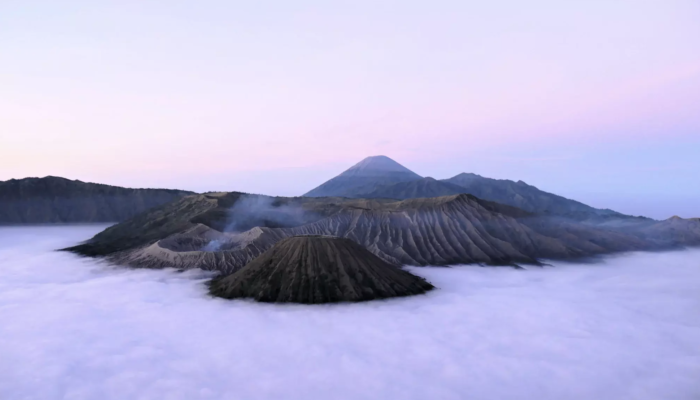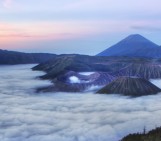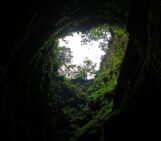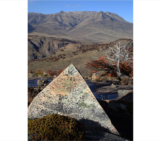
Featured in this photo, rising out from a sea of violet fog at dawn, is one of Indonesia’s most iconic volcanoes, Mount Bromo. The mountain is a large volcanic crater, also known as a caldera, which formed when an ancient cone volcano collapsed in the late Pleistocene and early Holocene epochs, between 126,000 and 8,300 years ago.
The current structure stands at 2,392 metres in the eastern region of the Indonesian island Java and is part of a larger volcanic complex. Mount Bromo is actually the youngest of five calderas, the first of which began to take shape more than 820,000 years ago. Since 1804, Mount Bromo has erupted more than 55 times, making it one of the most active volcanoes in Indonesia. The most recent eruption occurred earlier this year, starting in mid February and lasting until late July. The event produced plumes of ash that rose up to nearly 4,000 metres in altitude and generated local small tremors.
The closest neighbors of this volcano complex are the Tenggerese, an ethnic minority of more than 600,000 people, whose villages dot eastern Java. Mount Bromo plays a significant role for the Hindu members of the Tenggerese, as much of the community perceives the caldera as a deity and central symbol in their culture. The name Bromo is a variation of the name Brahma, the god of creation in the Hindu religion.
Every year on the 14th day of the month of Kasada in the traditional Tenggerese calendar many members of the community make a pilgrimage to the volcano’s caldera to offer Mount Bromo gifts of fruit, rice, vegetables, flowers, and livestock. Through this holiday, called Yadnya Kasada, the local population shows their appreciation for the blessings and welfare they believe to receive from the volcano.
While Mount Bromo’s volcanic activity can be quite disruptive (the economic loss from the volcano’s eruptions in 2010 were estimated to be about 15.5 million USD), some scientists indeed have looked into the benefits that the volcano presents. By interviewing members of the communities that co-exist with Mount Bromo, a team of researchers found that many of the Tenggerese see these eruptions as opportunities for improving their livelihood in the long term. For example, the surveyed locals pointed out that the volcanic ash helps the surrounding land become more fertile, lahars can increase agricultural activity, and landslides can improve soil quality.
In this way, when the Mount Bromo speaks, it answers the community’s prayers. “The voice of the Creator can be heard along the narrow rim of the main crater,” said Matteo Basilici and Roberto Ercoli, researchers at the University of Urbino “Carlo Bo” who snapped this photo. “It’s the moan from the magma chamber.”
By Olivia Trani, EGU Communications Officer
References
Smithsonian Institution Global Volcanism Program: Tengger Caldera
Bachri, S., Stötter, J., Monreal, M. and Sartohadi, J.: The calamity of eruptions, or an eruption of benefits? Mt. Bromo human–volcano system a case study of an open-risk perception, Natural Hazards and Earth System Sciences, 15(2), 277–290, doi:10.5194/nhess-15-277-2015, 2015.
Imaggeo is the EGU’s online open access geosciences image repository. All geoscientists (and others) can submit their photographs and videos to this repository and, since it is open access, these images can be used for free by scientists for their presentations or publications, by educators and the general public, and some images can even be used freely for commercial purposes. Photographers also retain full rights of use, as Imaggeo images are licensed and distributed by the EGU under a Creative Commons licence. Submit your photos at http://imaggeo.egu.eu/upload/.




